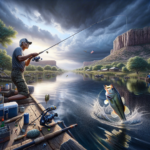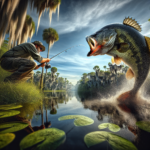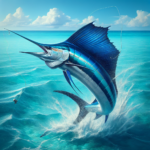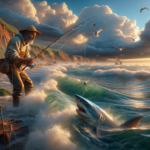Bass Fishing in Texas: Top Spots and Techniques

Introduction
Did you know that Texas is home to some of the best bass fishing in the United States? With over 1,100 public lakes and reservoirs, the Lone Star State offers a plethora of opportunities for anglers of all skill levels. This article will guide you through the top bass fishing spots in Texas, the most effective techniques, and essential gear recommendations to make your fishing trip a success.
Whether you’re a seasoned angler looking to explore new waters or a beginner eager to catch your first bass, understanding the best locations, techniques, and seasonal considerations can significantly enhance your fishing experience. Let’s dive into the world of bass fishing in Texas and discover what makes it a premier destination for anglers.
Background/Context
Historical or Cultural Significance
Bass fishing has deep roots in Texas culture, dating back to the early 20th century when the state began stocking its waters with largemouth bass. Over the years, Texas has become a hotspot for bass fishing enthusiasts, thanks to its diverse aquatic ecosystems and well-managed fisheries. The Texas Parks and Wildlife Department (TPWD) has played a crucial role in maintaining healthy fish populations and promoting sustainable fishing practices.
Geographical Overview
Texas boasts a wide range of fishing environments, from sprawling reservoirs and winding rivers to small ponds and coastal marshes. The state’s varied climate and topography create ideal conditions for bass fishing year-round. Key regions include East Texas, known for its lush forests and abundant lakes, and Central Texas, home to the Highland Lakes chain and the Colorado River.
Key Points/Details
Fishing Techniques
Technique Overview
Several techniques are effective for bass fishing in Texas, including:
- Topwater Fishing: Using lures that float on the water’s surface to attract bass.
- Jigging: Employing weighted lures to mimic prey movements near the bottom.
- Spinnerbait Fishing: Utilizing lures with spinning blades to create vibrations and flash.
- Crankbait Fishing: Using lures that dive and wobble to imitate baitfish.
When and Where to Use
Topwater fishing is most effective during early morning and late evening when bass are feeding near the surface. Jigging works well in deeper waters and around structures like submerged trees and rocks. Spinnerbaits are versatile and can be used in various conditions, while crankbaits are ideal for covering large areas quickly.
Recommended Gear
- Rods: Medium to heavy-action rods for strength and sensitivity.
- Reels: Baitcasting reels for precision and control.
- Lines: Braided or fluorocarbon lines for durability and low visibility.
- Bait/Lures: Topwater lures, jigs, spinnerbaits, and crankbaits.
Species Information
Species Overview
The primary species targeted in Texas are largemouth bass, smallmouth bass, and Guadalupe bass. Largemouth bass are the most common and can be found in various habitats, from shallow ponds to deep reservoirs. Smallmouth bass prefer cooler, clearer waters with rocky substrates, while Guadalupe bass are native to the Edwards Plateau region and thrive in fast-flowing streams.
Best Practices
To successfully catch bass, consider the following tips:
- Understand Seasonal Behavior: Bass are more active during spring and fall when water temperatures are moderate.
- Use Appropriate Lures: Match your lure selection to the bass’s feeding habits and the local forage.
- Fish Near Structures: Bass often hide near structures like submerged logs, vegetation, and drop-offs.
Location Information
Top Fishing Spots
Some of the best bass fishing spots in Texas include:
- Lake Fork: Known for producing trophy-sized largemouth bass.
- Sam Rayburn Reservoir: A top destination for bass tournaments.
- Lake Amistad: Offers clear waters and abundant bass populations.
- Toledo Bend Reservoir: Straddles the Texas-Louisiana border and is renowned for its bass fishing.
- Lake Texoma: Home to both largemouth and smallmouth bass.
Regulations and Licenses
Before fishing in Texas, ensure you have a valid fishing license. The TPWD website provides information on license types, fees, and purchasing options. Be aware of local regulations, including size and bag limits, and any seasonal restrictions to promote sustainable fishing practices.
Seasonal Considerations
Seasonal Variations
Fishing conditions in Texas change throughout the year:
- Spring: Bass spawn in shallow waters, making them more accessible.
- Summer: Bass move to deeper, cooler waters during the heat of the day.
- Fall: Bass feed aggressively to prepare for winter, offering excellent fishing opportunities.
- Winter: Bass are less active but can still be caught in deeper waters.
Best Times to Fish
The optimal times for bass fishing are early morning and late evening when bass are most active. Seasonal peaks include the spring spawning period and the fall feeding frenzy.
Events and Tournaments
Event Overview
Texas hosts numerous bass fishing tournaments, including:
- Texas Bass Classic: Held annually on Lake Fork.
- Sam Rayburn Big Bass Splash: A popular amateur tournament.
- Toledo Bend Bass Tournament: Attracts anglers from across the country.
Preparation Tips
To prepare for a tournament, consider the following:
- Practice: Spend time on the water to familiarize yourself with the fishing conditions.
- Gear Check: Ensure your equipment is in top condition and bring backups.
- Strategy: Develop a game plan based on local knowledge and scouting reports.
Tips and Best Practices
General Tips
- Stay Patient: Bass fishing requires patience and persistence.
- Observe Nature: Pay attention to bird activity and water conditions to locate fish.
- Adapt: Be willing to change techniques and lures based on the conditions.
Avoid Common Mistakes
- Overcasting: Avoid casting too far from your target area.
- Ignoring Weather: Weather changes can significantly impact bass behavior.
- Using the Wrong Gear: Match your gear to the fishing conditions and target species.
Advanced Techniques
- Drop Shotting: A finesse technique for targeting bass in deep waters.
- Flipping and Pitching: Effective for fishing heavy cover and precise presentations.
- Swimbait Fishing: Using large, realistic lures to attract big bass.
Gear and Equipment Recommendations
Essential Gear
- Rods: Medium to heavy-action rods.
- Reels: Baitcasting reels.
- Lines: Braided or fluorocarbon lines.
- Lures: Topwater lures, jigs, spinnerbaits, crankbaits.
Optional Gear/Upgrades
- Fish Finder: Helps locate fish and underwater structures.
- Tackle Box: Organizes and stores your lures and accessories.
- Polarized Sunglasses: Reduces glare and improves visibility.
Where to Buy or Rent
You can purchase or rent fishing gear from local shops like Bass Pro Shops, Cabela’s, and Academy Sports + Outdoors. Online retailers like Amazon and Tackle Warehouse also offer a wide selection of fishing equipment.
Safety and Conservation
Safety Tips
- Weather Awareness: Check the weather forecast and be prepared for sudden changes.
- Life Jackets: Always wear a life jacket when on the water.
- Hydration: Stay hydrated, especially during hot weather.
Conservation Practices
- Catch and Release: Practice catch and release to preserve fish populations.
- Respect Wildlife: Avoid disturbing local wildlife and habitats.
- Follow Regulations: Adhere to local fishing regulations and guidelines.
Planning Your Trip
Accommodations
Consider staying at local lodges, campgrounds, or hotels near popular fishing spots. Some recommended options include:
- Lake Fork Marina & Motel: Offers convenient access to Lake Fork.
- Sam Rayburn Marina Resort: Located on the shores of Sam Rayburn Reservoir.
- Amistad National Recreation Area: Provides camping facilities near Lake Amistad.
Travel Tips
- Routes: Plan your route using GPS or maps to avoid getting lost.
- Transportation: Ensure your vehicle is equipped to handle rough terrain if necessary.
- Local Knowledge: Seek advice from local anglers or guides for the best fishing spots.
Additional Activities
While in Texas, explore other activities such as hiking, bird watching, and visiting local attractions like state parks and historical sites. This makes the trip enjoyable for non-anglers in your group as well.
Frequently Asked Questions (FAQs)
What is the best time of year for bass fishing in Texas?
The best times are during the spring and fall when bass are more active and feeding aggressively.
Do I need a fishing license to fish in Texas?
Yes, a valid fishing license is required for anyone over the age of 17. Licenses can be purchased online or at local retailers.
What are the most effective lures for bass fishing in Texas?
Topwater lures, jigs, spinnerbaits, and crankbaits are all effective for bass fishing in Texas waters.
Can I fish from the shore, or do I need a boat?
You can fish from both the shore and a boat. Many lakes and reservoirs have designated fishing piers and shore access points.
Conclusion
Bass fishing in Texas offers a unique and rewarding experience for anglers of all levels. By understanding the best fishing spots, techniques, and seasonal considerations, you can maximize your chances of success. Remember to follow local regulations, practice conservation, and prioritize safety to ensure a sustainable and enjoyable fishing adventure. So grab your gear, head to the Lone Star State, and experience some of the best bass fishing in the country!




